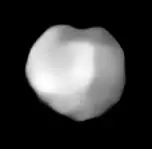89 Julia
Julia (minor planet designation: 89 Julia) is a large main-belt asteroid that was discovered by French astronomer Édouard Stephan on August 6, 1866. This was first of his two asteroid discoveries; the other was 91 Aegina. 89 Julia is believed to be named after Saint Julia of Corsica. A stellar occultation by Julia was observed on December 20, 1985.
 VLT-SPHERE image of Julia. The large crater Nonza, half the diameter of the asteroid, is centered on the upper left quadrant. | |
| Discovery | |
|---|---|
| Discovered by | Édouard Stephan |
| Discovery date | 6 August 1866 |
| Designations | |
| (89) Julia | |
| Pronunciation | /ˈdʒuːliə/[1] |
Named after | Julia of Corsica |
| Main belt | |
| Adjectives | Julian /ˈdʒuːliən/ |
| Orbital characteristics [2] | |
| Epoch 31 July 2016 (JD 2457600.5) | |
| Uncertainty parameter 0 | |
| Observation arc | 149.68 yr (54672 d) |
| Aphelion | 3.0202 AU (451.82 Gm) |
| Perihelion | 2.08017 AU (311.189 Gm) |
| 2.55016 AU (381.499 Gm) | |
| Eccentricity | 0.18430 |
| 4.07 yr (1487.5 d) | |
| 255.367° | |
| 0° 14m 31.272s / day | |
| Inclination | 16.128° |
| 311.563° | |
| 45.461° | |
| Physical characteristics | |
| Dimensions | (89±2)×(80±1)×(62±3) km[3] |
Mean diameter | 140±3 km[3] 151±3 km[2] 148±8 km[4] |
| Mass | (4.3±3.6)×1018 kg[3] (6.7±1.8)×1018 kg[4] |
Mean density | 3.0±2.6 g/cm3[3] 4.0±1.3 g/cm3[4] |
| 11.388336±0.000001 h (0.4745 day)[3] | |
| 0.1764±0.007[2] 0.176 [5] | |
| S | |
| 8.74 to 12.61[6] | |
| 6.60 | |
| 0.18" to 0.052" | |
The spectrum of 89 Julia shows the signature of silicate rich minerals with possible indications of an abundant calcic clinopyroxene component. It is classified as an S-type asteroid. The asteroid has an estimated diameter of 151.4±3.1 km.[7] Photometry from the Oakley Observatory during 2006 produced a lightcurve that indicated a sidereal rotation period of 11.38±0.01 with an amplitude of 0.20±0.02 in magnitude.[8]
Nonza crater and Julian family
89 Julia is the parent body of the eponymous Julia family of asteroids. Observations of 89 Julia by the VLT's SPHERE instrument identified a 'highly probable' crater 70–80 km in diameter and 4.1±1.7 km deep in the southern hemisphere as the only visible possible source of the family.[9] The crater was named Nonza by the discoverers, referring to the commune on the island of Corsica where Saint Julia was born.[10] The excavated volume is on the order of 5,000 to 15000 km3. It is hypothesized an impact 30 to 120 million years ago by another body approximately 8 kilometers in diameter may have created the collisional family.
References
- Noah Webster (1884) A Practical Dictionary of the English Language
- Yeomans, Donald K., "89 Julia", JPL Small-Body Database Browser, NASA Jet Propulsion Laboratory, retrieved 13 May 2016.
- Vernazza et al. (August 2018) The impact crater at the origin of the Julia family detected with VLT/SPHERE?, Astronomy and Astrophysics 618, DOI: 10.1051/0004-6361/201833477
- Carry, B. (December 2012), "Density of asteroids", Planetary and Space Science, 73 (1): 98–118, arXiv:1203.4336, Bibcode:2012P&SS...73...98C, doi:10.1016/j.pss.2012.03.009. See Table 1.
- Asteroid Data Sets Archived 2009-12-17 at the Wayback Machine
- "AstDys (89) Julia Ephemerides". Department of Mathematics, University of Pisa, Italy. Retrieved 27 June 2010.
- Birlan, Mirel; Barucci, Maria Antonietta; Vernazza, Pierre; Fulchignoni, Marcello; Binzel, Richard P.; Bus, Schelte J.; et al. (June 2004). "Near-IR spectroscopy of asteroids 21 Lutetia, 89 Julia, 140 Siwa, 2181 Fogelin and 5480 (1989YK8), potential targets for the Rosetta mission; remote observations campaign on IRTF". New Astronomy. 9 (5): 343–351. arXiv:astro-ph/0312638. Bibcode:2004NewA....9..343B. doi:10.1016/j.newast.2003.12.005.
- Ditteon, Richard; Hawkins, Scot (September 2007), "Asteroid Lightcurve Analysis at the Oakley Observatory - October-November 2006", The Minor Planet Bulletin, 34 (3): 59–64, Bibcode:2007MPBu...34...59D, ISSN 1052-8091.
- Vernazza, P.; Broz, M.; Drouard, A. "Astronomy & Astrophysics (A&A)". www.aanda.org. Retrieved 20 December 2019.
- Vernazza, P. "ESO/VLT/SPHERE Survey of D>100km Asteroids : First Results" (PDF). USRA. Retrieved 20 December 2019.
External links
- 89 Julia at AstDyS-2, Asteroids—Dynamic Site
- 89 Julia at the JPL Small-Body Database
